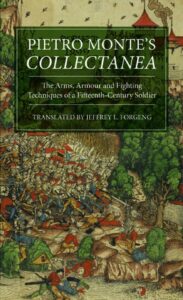Jeffrey L. Forfeng (ed.)
Montius, Petrus, Pietro Monte’s Collectanea: The Arms, Armour and Fighting Techniques of a Fifteenth-Century Soldier
(The Boydell Press, 2018), 333 pp. $99.00.

Pietro Monte’s Exercitiorum atque artis militaris collectanea in tris [sic.] libros distincta (printed at Milan, in folio, 1509) is not easily categorised. It is part conduct manual, part military theory, part catalogue of morals and values, part fencing instruction, part manual of arms. That scope is practically unique in this period and while we should be must be cautious in using such a rare outlier to study the martial and moral pedagogy of the transitional period of the sixteenth century, it is now finally available to a wider audience thanks to Jeffrey Forgeng’s accessible edition, as part of Boydell’s Arms and Armour series. That Boydell has committed to bringing this work to press is encouraging and although on the face of things, Monte’s work seems likely to appeal only to the sword-beard set (forgive the colloquialism).
Monte’s significance for other disciplines cannot be over-stated, even if his influence was likely negligible. Monte says little new about many of the things he covers but the fact that he covers them so comprehensively, and in one collection, is itself original. Didactic and theoretical literature of the late medieval and early-modern period followed the genre conventions of the classics which segregated disciplines into their own discreet texts. Mixing these works together was discouraged. For instance, you will never find a copy of the classic late-Roman military theorist Vegetius co-habiting the same volume as a technical work on siege equipment or swordsmanship. Monte ignores this division and, aggressively, draws parallels between the practical and theoretical, perhaps most strikingly, in his discussion of the characteristics that make up a good fighter (chapters 68-90, pp. 72-90). Monte pulls indiscriminately from medical philosophy, geography, history, the symbolic relationships between animals and man, and his own practical knowledge and interpretations. The material covered is not new, but his synthesis is probably unique for the period.
Forgeng is no stranger to obscure, multi-disciplinary, texts of martial education, having edited several volumes of illustrated manuals for other publishers. This familiarity is essential when explaining Monte as his collection is a kind of sample or contemporary, courtly, literature for the semi-professional men amongst the martial and social elites for whom the book was originally composed. Forgeng’s introductory material gives us as complete a portrait as is possible of Monte; a man of unremarkable, but still gentile origins who worked in the circles of courtiers such as Baldesare Castiglione and artists as significant as De Vinci. Monte’s work reflects that diversity and while Forgeng situates this text within the medieval corpus of instruction in swordsmanship and other combat arts, it is Monte’s comments and reflections on the characters of his contemporaries (largely discussed as types, rather than individuals) that is perhaps more important for general readers.
Monte’s work most closely resembles the conduct manual genre than any other, although it is a conduct manual written explicitly for someone anticipating a military career. Monte explains how one should act and comport themselves, in martial situations but he also attempt to teach the mentality of the martial courtier. Forgeng contrasts Monte’s pedagogical approach to the subject of skill in arms with his contemporaries, none of whom attempted this particular approach. Fifteenth-century German texts (sometimes illustrated) provided readers with some general theoretical rules by which one could think their way through a fight. Others focused on teaching specific orders of movement and techniques (lessons in orthopraxis). Monte goes into greater detail in his explanations, giving readers his rational for doing one thing, and not another.
There are, naturally, limitations to this style of instruction, and the opacity of the language is often a barrier to readers but, as Forgeng is clearly aware, this was an issue for contemporary readers as well. In his capacity as translator and editor, Forgeng resists the temptation to give a running commentary on the work, which may disappoint some readers less familiar with the peculiarities of genre. However, this edition does give enough context and collates the Collectanea with Monte’s other related work in a way that helps readers see these connections and pick up on the originality of Monte, organically.
Forgeng’s presentation of the technical aspects of the material text (dates of production, surviving copies, editorial chain of progression) could more closely follow the conventions of other book histories. The text does present some editorial challenges. Monte poached material from several of his previous works for this collection and Forgeng has traced those connections where they appear and where they differ. However, the details of the associated texts is not always clear. Which ones are print and which are manuscript? Which of the print texts pre- or post-date the Collectanea? I hesitate to criticize this point too strongly as it is entirely possible that this information is present in Forgeng’s edition, and that I have simply missed it. Certainly, this kind of forensic bibliography is not essential for all readers of Monte, but some clarity on this point would be appreciated.
This is a challenging text for any reader but it is also hugely rewarding and Forgeng’s cleanly rendered translation of an overlooked and contextually isolated work is a meaningful contribution to the history of martial pedagogy, culture, and the history of late-medieval and early-modern training and practice in arms. It is a joy to see it available from Boydell.
Mark Geldof
